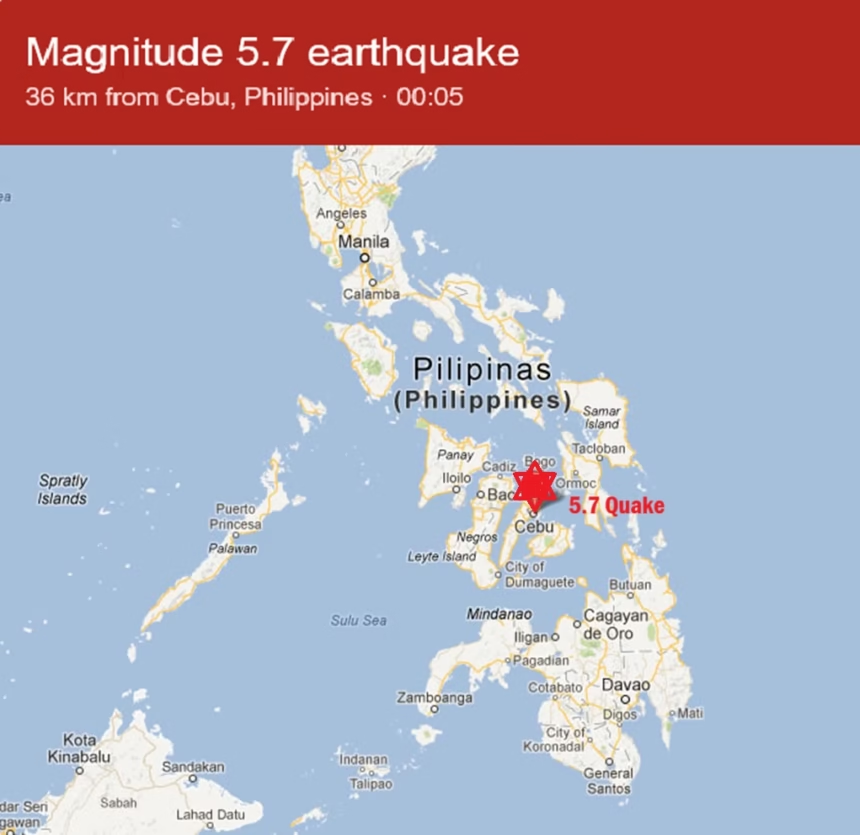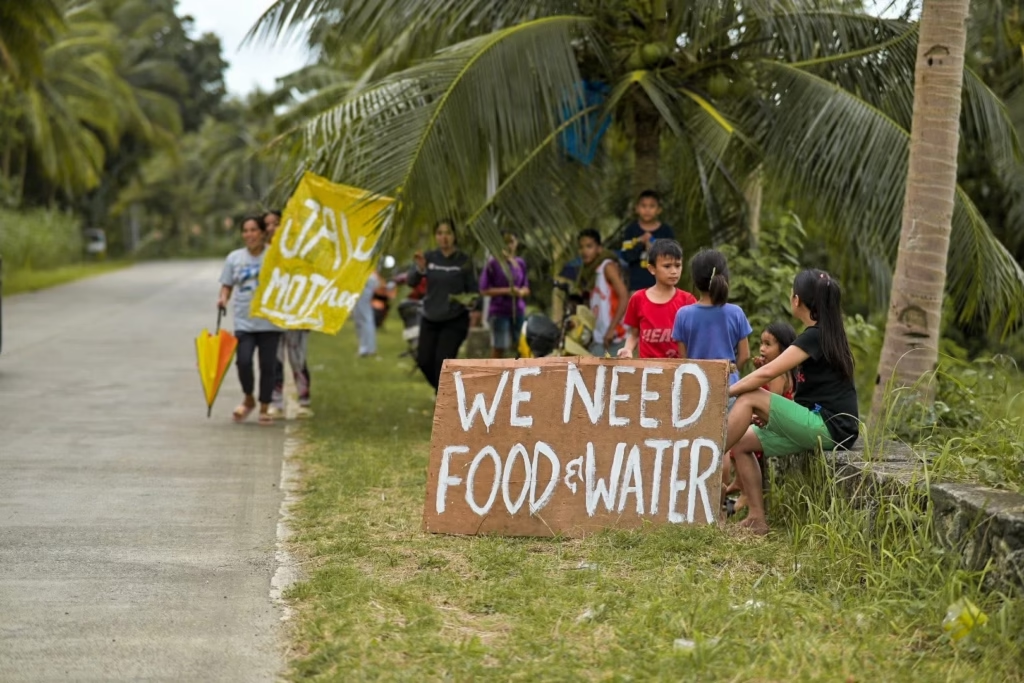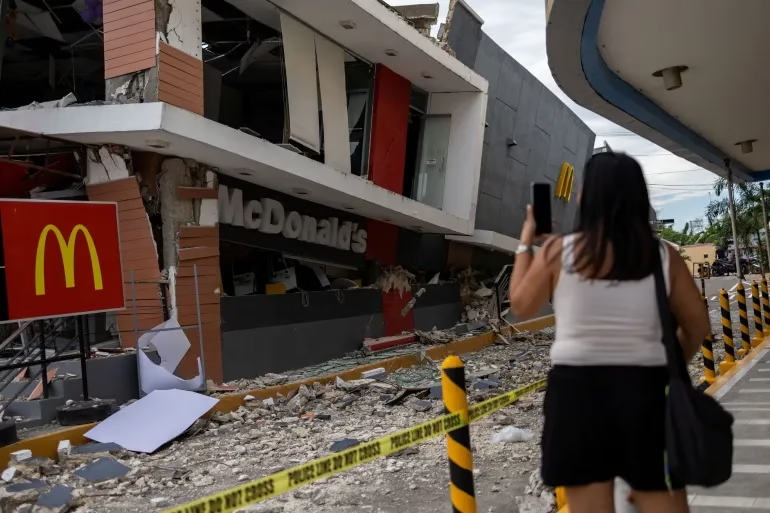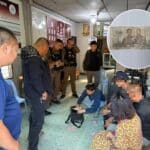CEBU CITY – In the pre-dawn hush of October 13, 2025, the resilient island province of Cebu was rudely awakened once more by the earth’s unforgiving rumble. A magnitude 5.7 earthquake struck at 1:06 a.m. Philippine Standard Time, its epicenter pinpointed 36 kilometers northeast of Cebu City, off the coast near Bogo City in northern Cebu.
The Philippine Institute of Volcanology and Seismology (PHIVOLCS) quickly downgraded the initial report from magnitude 6.0 to 5.7, but the jolt—described by residents as a “savage shove”—sent panicked families fleeing into the streets, their hearts pounding with echoes of trauma still fresh from just 13 days prior.
This latest seismic visitor, shallow at a depth of approximately 10 kilometers, rattled windows and swayed lampposts across northern Cebu, with instrumental intensities reaching Intensity V (Strong) in nearby Villaba, Leyte, and Intensity IV (Moderately Strong) in Danao City, Asturias, Argao City, Talisay, and Cebu City itself.
Tremors rippled into southern Leyte towns like Isabel, Hilongos, Ormoc City, Abuyog, and Hinunangan, where schoolchildren clutched desks in the dark. No immediate casualties have been reported, a small mercy in a region where every aftershock feels like a loaded gun. But PHIVOLCS Director Teresito Bacolcol issued a stark advisory: “Expect further aftershocks, some potentially damaging. Evacuate unstable structures and prepare for the worst.”
Cebu Still in Recovery
For the 3.4 million souls of Cebu—many still encamped in makeshift tents, their homes reduced to rubble—the quake was not just a geological event but a cruel reminder of vulnerability. “We thought the big one was behind us,” said Maria Lopez, a 52-year-old fish vendor from Bogo City, her voice cracking over a crackling phone line as she huddled with her grandchildren under a tarpaulin shelter.
“The ground betrayed us again. How much more can we take?” Lopez’s stall, already splintered by the prior disaster, now tilts precariously, a casualty of the relentless barrage.
This tremor caps a fortnight of seismic fury that has battered the archipelago, turning the Philippines into a tinderbox of natural wrath. Since September 30, when a magnitude 6.9 behemoth off Daanbantayan claimed at least 74 lives and injured over 300, the nation has endured a cascade of quakes that experts liken to a “swarm unleashed.”
By October 11, PHIVOLCS had tallied 10,662 aftershocks from the Cebu event alone, peaking with a 5.3-magnitude shaker on October 3. But the archipelago’s woes didn’t end there. On October 10, twin offshore monsters—a 7.4 followed by a 6.8—slammed Mindanao’s Davao Oriental, killing seven, toppling hospitals and schools, and spawning tsunami warnings that sent coastal folk scrambling to higher ground. Waves lapped 17 centimeters above the tide in Indonesia’s North Sulawesi, a grim harbinger.
The past two weeks have etched a grim ledger: over 80 deaths nationwide, 23,562 displaced in Cebu alone, and 79,959 homes damaged or destroyed, per the National Disaster Risk Reduction and Management Council (NDRRMC). Power grids flickered out in Visayas and Mindanao, stranding Leyte, Samar, and Bohol from the Cebu-Negros-Panay backbone.
Relief Convoys Bring Supplies
Landslides entombed 14 in Bogo, while historic churches—centuries-old sentinels of faith like the Archdiocesan Shrine of Sta. Rosa de Lima in Daanbantayan and Saints Peter and Paul Parish on Bantayan Island—crumbled into spectral ruins, their belfries toppled like dominoes in viral footage that broke Filipino hearts worldwide.
Cebu’s recovery from the September 30 cataclysm was, until this morning, a testament to bayanihan spirit amid bureaucratic grit. Governor Pam Baricuatro, her face etched with exhaustion in daily briefings, declared a “state of calamity” on October 1, unlocking P1.2 billion in quick-response funds.
Relief convoys ferried rice at P20 per kilogram—a government lifeline extended for a month—alongside water, medicine, and tents to the 722,919 affected. The Department of Social Welfare and Development (DSWD) tallied P500 million in aid distributed by October 12, with child-friendly spaces sprouting in evacuation centers to soothe quake-traumatized youth.
“We’ve cleared 70% of debris from main roads,” Baricuatro told reporters last week, her voice steady despite the deluge of aftershocks. “Classes resume asynchronously next week; our kids can’t afford more lost time.”
Yet progress is fragile. Power outages persist in Bogo and Medellin, where the Visayan Electric Company scrambles to mend lines severed by the initial 6.9. Hospitals, overwhelmed with the injured, now brace for psychological fallout—”earthquake-induced episodes,” as Mandaue Mayor Jonas Cortes calls the panic attacks gripping 74 students.
Philippines Cursed Geography
Cebu City’s bustling ports, economic lifelines, hum at half-capacity, tourism—a P100-billion pillar—limps with canceled flights and shuttered resorts. “We’re rebuilding brick by brick,” said Provincial Information Officer Ainjeliz de la Torre-Orong, “but these tremors are like salt in the wound.”
Why now? Why this relentless parade of quakes in a nation already lashed by back-to-back typhoons that drowned 27 last month? Experts at PHIVOLCS and beyond point to the Philippines’ cursed geography: a 7,641-island bullseye in the Pacific Ring of Fire, where the Philippine Sea Plate grinds northwest into the Eurasian Plate at 7-8 centimeters yearly, birthing the 1,200-kilometer Philippine Fault Zone—a serpentine scar responsible for many a historic horror.
The September 30 leviathan, PHIVOLCS revealed on October 1, ruptured along the newly christened Bogo Bay Fault, a stealthy underwater fissure dormant for over 400 years, undetected because its tremors were too feeble to flag. “Cebu wasn’t the hotspot we thought,” explained Dr. Bacolcol in a primer released last week.
“But stresses from the 2017 Leyte quakes—magnitude 6.5 and 6.1 on the Philippine Fault—piled up here, like a spring coiled too tight.” Dr. Mario Aurelio, a geologist at the University of the Philippines’ National Institute of Geological Sciences, echoed this in a Rappler interview: “It’s nature’s release valve. The 2017 events transferred strain southward, awakening this fault. Cebu felt eight strong quakes from 1885-2013, but nothing like this.”
The October 13 event? A classic aftershock, Bacolcol affirmed in a midday update, “energy readjusting along the same fault plane.” Yet the Mindanao doubleheader, though unrelated per PHIVOLCS analysis, underscores the archipelago’s interconnected peril. “The Philippine Trench off Davao fueled those—pure subduction fury,” said Dr. Judith Hubbard, a Cornell University seismologist, in a Washington Post analysis. “No conspiracy of faults, just the Ring of Fire doing what it does: reminding us we’re on borrowed ground.”
Filipinos, ever the survivors, rally with grim humor and unyielding faith. In Bogo’s evacuation camps, priests led dawn Masses amid the rubble, invoking resilience against “disaster fatigue,” as Bacolcol termed it.
President Ferdinand Marcos Jr., surveying Davao wreckage via drone last Friday, vowed to tap 2025’s surplus budget for a “disaster war chest,” heeding calls from Rep. Jose Alvarez. “We’ve faced worse,” Marcos said, channeling the stoic pulse of a people forged in fire. But as aftershocks whisper threats into the night, one wonders: How many more jolts before the next big one?
For Cebu, recovery isn’t linear—it’s a seismic dance, two steps forward, one violent lurch back. As dawn broke on this battered Monday, volunteers shoveled debris under a mercifully clear sky, their shovels scraping against stone. Maria Lopez, wiping dust from her eyes, glanced seaward. “The earth will shake again,” she murmured. “But so will we.”
















